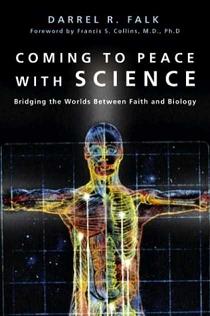Every Friday, “Science and the Sacred” features an essay
from a guest voice in the science and religion dialogue. This week’s
guest entry was written by David Opderbeck. Opderbeck is a professor of law at Seton Hall University School of Law and serves in the school’s Gibbons Institute of Law, Science & Technology. His blog Through a Glass Darkly addresses issues in theology and the science and religion dialogue.
On December, 2005, Judge John E. Jones, III (left) issued his opinion in the now-infamous Kitzmiller v. Dover Area School District intelligent design case. Like many thoughtful evangelical Christians at the time, I was impressed with intelligent design theory. I had read many of the ID movement’s foundational texts, and felt confident that ID offered an intellectually and theological satisfying alternative to the extremes of young earth creationism and atheistic Darwinism. Shortly after the Kitzmiller decision was issued, I blogged and wrote publicly
about Judge Jones’ opinion, which I thought was largely mistaken.
I still think Judge Jones’ opinion in Kitzmiller missed the mark in some important ways, even though I think (and have always thought) the end result was correct. Moreover, I remain impressed with the energy and intelligence of the ID movement’s thought leaders. Scholars such as Bill Dembski and Mike Behe have made some interesting arguments about epistemology, divine action, and causation. However, when I dove into the broader ID discussion after the Kitzmiller case, I came to believe that many aspects of the ID movement are not as helpful as I had first thought – and, indeed, that ID rhetoric is often used to hinder positive interaction between the truths of the Christian faith and truths learned through the natural sciences.
What I’d like to start to explore in this post is how my thinking about ID, Kitzmiller, and the interface of faith, science, and the public schools, has, and hasn’t, changed since 2005. In order to begin this discussion, we need to consider some legal history.
Most readers of “Science and the Sacred” likely are familiar with the Scopes case from 1926, in which a legal challenge to the teaching of evolution in public schools failed. I won’t rehearse the details of the Scopes case here, nor will I attempt to enter into the lively debate about whether the play “Inherit the Wind,” based on the trial, really does justice to all the participants. More significant for our purposes is a series of cases in the 1980s in which young earth creationists attempted to introduce “creation science” into the public schools. The key cases include McLean v. Arkansas Board of Education, 529 F. Supp. 1255 (1982) and Edwards v. Aguillard, 482 U.S. 578 (1987).
The “creationism cases” capture a fascinating, if troubling, moment in evangelical cultural history. A decade earlier, Roe v. Wade, the U.S. Supreme Court’s famous abortion decision, had galvanized previously complacent evangelicals into social action. The model of engagement evangelicals tended to adopt was one of confrontation through legislation and litigation. By the 1980s, the “religious right” was on the ascendancy. The creationism cases represent a wave front of culture war activity that swept over the popular evangelical subculture and continues to reverberate today.
It’s not surprising that the courts in the creationist cases uniformly struck down efforts to introduce “creation science” into public school curricula. The results in McLean and Aguillard were not, I believe, the results of “judicial activism,” but rather reflected a standard and appropriate application of Supreme Court jurisprudence under the establishment clause of the first amendment to the U.S. Constitution. It was clear from the record in the creationist cases that “creation science” represented a particular interpretation of a uniquely religious perspective on the origins of the universe. The source of young earth creationist beliefs was a supposedly “literal” interpretation of the Bible. In effect, the proponents of “creation science” desired introduce their Biblical apologetics into the public schools.
In the same way, I don’t think Judge Jones was playing the role of “activist judge” in the Kitzmiller case. It seems clear from the trial record that the Dover, Pennsylvania school board officials who promoted the ID curriculum did so in an effort to support their belief in a particular form of direct creationism. Although ID is ostensibly a religiously neutral theory, the local pro-ID school board officials in Dover appeared to have specifically religious motives for introducing it into the curriculum. This was enough reason, I think for Judge Jones to have rejected their efforts. (In a separate post, I’ll address Judge Jones’ ruling about whether ID is “science,” which I believe reflects a number of problems in how the law handles the question of how to define “science.”)
I’ve come to believe that the misuse of ID theory by those Dover school board members reflects a common misuse of ID in the Church generally. In my experience, it’s widely assumed by evangelical church-goers – contrary to the official statements of leaders in the ID movement – that ID supports belief in God, or more specifically supports young earth creationism, over and against evolution. Countless apologetics programs, websites, and publications designed for evangelicals respond to any suggestion that biological evolution may be true (or that direct creationism may be false) with a passing reference to Mike Behe and Bill Dembski. These would-be apologists are sometimes shocked to learn that many ID theorists accept common descent, which definitely is not compatible with special creationism (or sometimes they know better and conveniently fail to mention that fact in their presentations!).
The unfortunate reality, in my judgment, is that ID theory – or rather, a crude distillation of ID theory – has been reduced to a tool in the culture wars both inside and outside the Church. Whether the leaders of the ID movement intended for this to happen or not, Christian proponents of ID are using it just as they tried to employ “creation science” in the 1980s. Within the Church, this tends to remove ID from the realm of ideas that can be calmly and reasonably discussed, and places it instead into a “hot button” category. Even worse, the Christian believer who has been schooled to view ID as a rock-solid defense against atheism will find his or her faith shaken if the central claims of ID theory fail to withstand scrutiny. This further heightens the perceived stakes in the culture wars: a failure of ID theory is viewed as a public blow to the credibility of the Christian gospel. In my view, this is a grave mistake, underwritten by some highly questionable theological assumptions.
In my next post, I’ll discuss problems with how American courts handle the question of “science.” In another post to come, I’ll unpack what I believe are the problematic theological assumptions underlying popular evangelical appropriations of ID theory for use in the public square.


